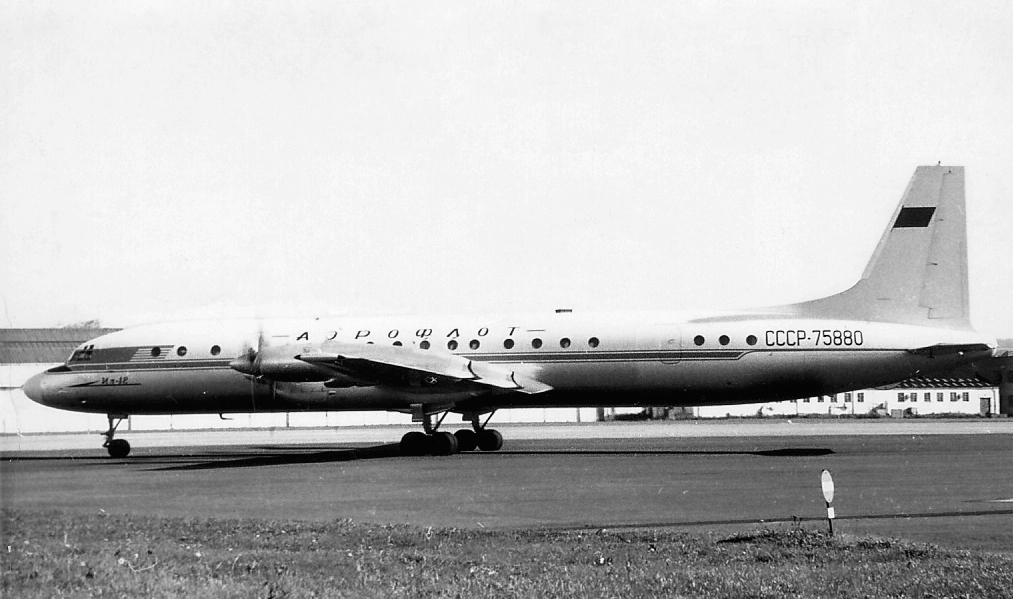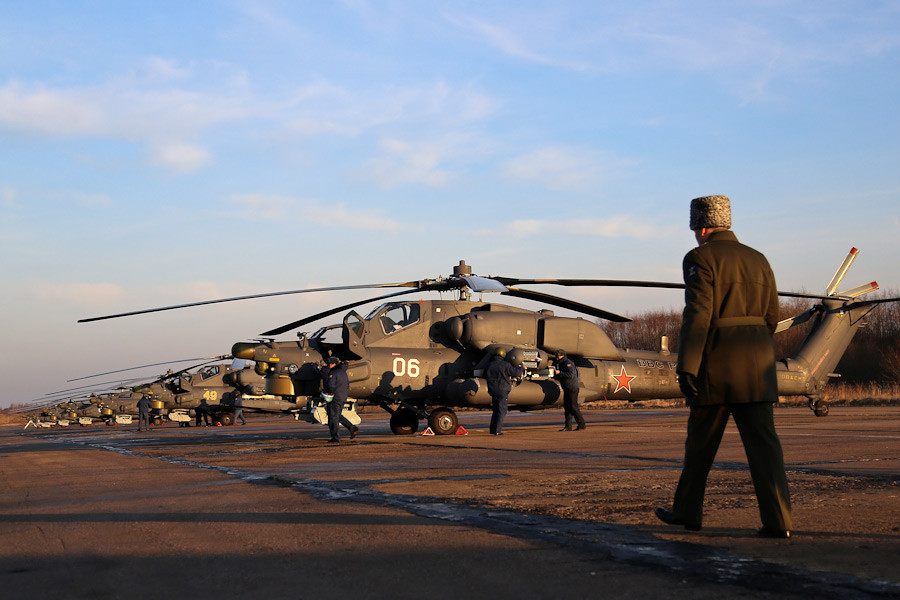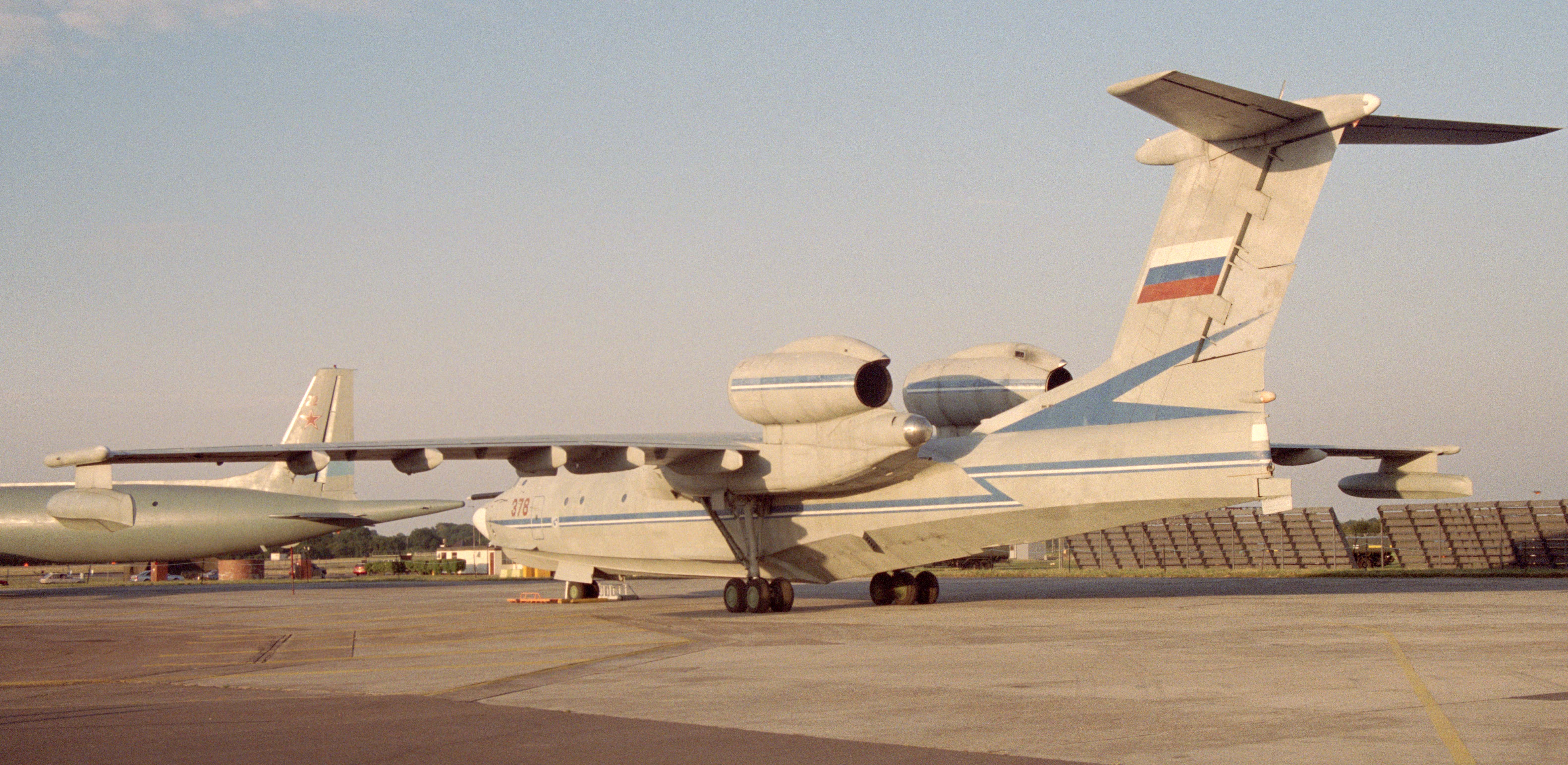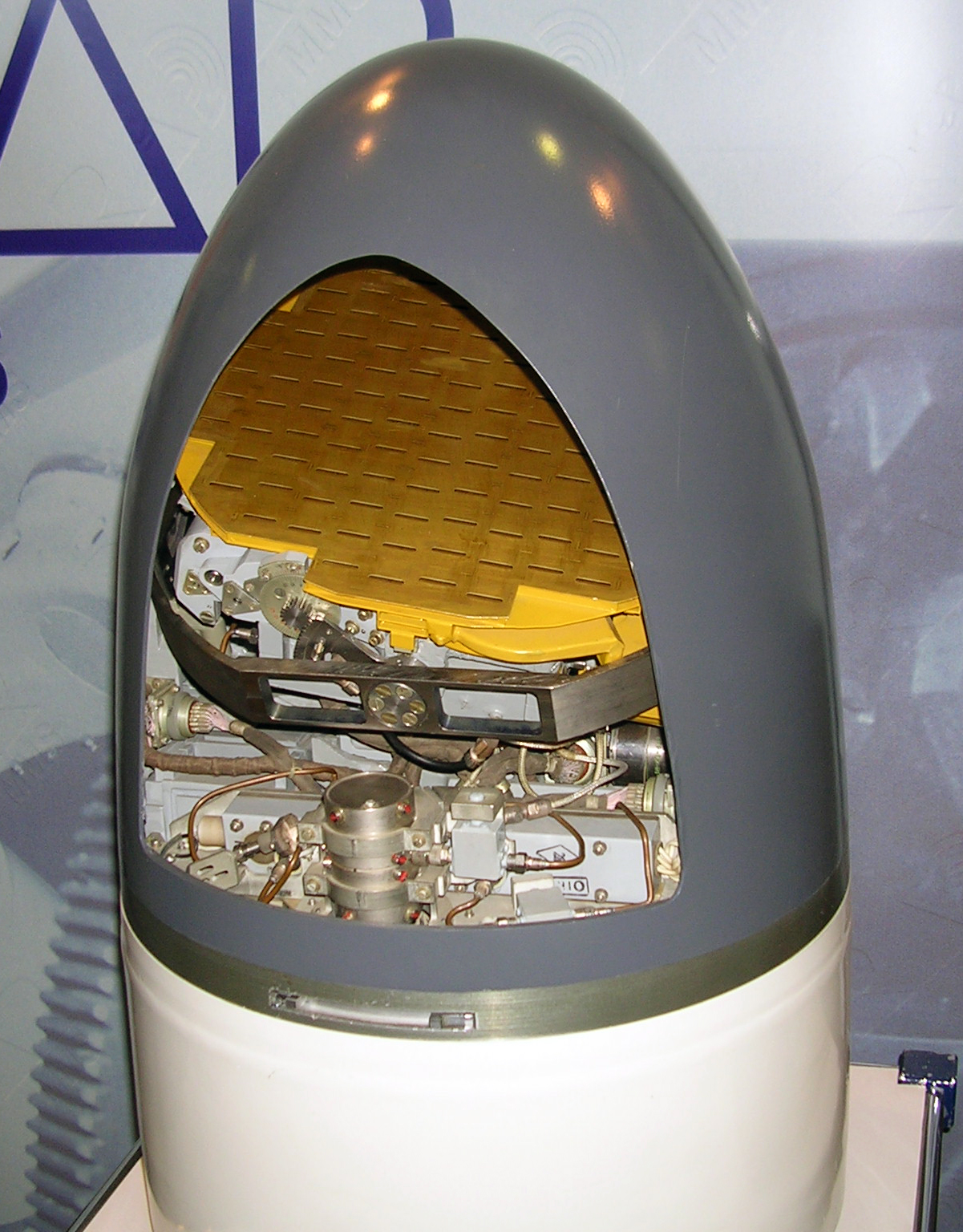|
Il-38
The Ilyushin Il-38 "Dolphin" ( NATO reporting name: May) is a maritime patrol aircraft and anti-submarine warfare aircraft designed in the Soviet Union. It was a development of the Ilyushin Il-18 turboprop transport. Design and development The Il-38 is an adaptation of the four-engined turboprop Ilyushin Il-18 for use as a maritime patrol aircraft for the Soviet Navy. It met a requirement to counter American ballistic missile submarines. The Communist Party Central Committee and the Council of Ministers issued a joint directive on 18 June 1960, calling for a prototype to be ready for trials by the second quarter of 1962. The fuselage, wing, tail unit and engine nacelles were the same as the Il-18 and it had the same powerplant and flight deck. An aerodynamic prototype of the Il-38 first flew on 28 September 1961,Lake 2005, p.31. with the first production aircraft following in September 1967. Production continued until 1972, when the longer-range and more versatile Tupolev Tu-1 ... [...More Info...] [...Related Items...] OR: [Wikipedia] [Google] [Baidu] |
Russian Naval Aviation
The Russian Naval Aviation ( rus, Авиация Военно-морского флота России, r=Aviatsiya Voenno-morskovo Flota Rossii) is the air arm of the Russian Navy, a successor of Soviet Naval Aviation. The Russian Navy is divided into four fleets and one flotilla: Northern Fleet, Pacific Fleet, Baltic Fleet, Black Sea Fleet, and Caspian Flotilla. The air forces of the largest and most important fleets, the Northern and Pacific fleets, operate long range Tu-142 anti-submarine warfare (ASW) aircraft, Il-38 medium-range ASW aircraft, and Ka-27 shipborne ASW and search-and-rescue (SAR) helicopters. Formations operating supersonic Tu-22M, Tu-22M3 bombers were transferred to the Russian Air Force's Long Range Aviation in 2011. The relatively small fleets, the Baltic and Black Sea, currently have only tactical Sukhoi Su-24, Su-24 bombers and ASW helicopters in service. The small Caspian Flotilla operates An-26 and Mil Mi-8, Mi-8 transports, Ka-27PS rescue helicopter ... [...More Info...] [...Related Items...] OR: [Wikipedia] [Google] [Baidu] |
Ilyushin Il-18
The Ilyushin Il-18 (russian: Илью́шин Ил-18; NATO reporting name: Coot) is a large turboprop airliner that first flew in 1957 and became one of the best known and most durable Soviet aircraft of its era. The Il-18 was one of the world's principal airliners for several decades and was widely exported. Due to the aircraft's airframe durability, many examples achieved over 45,000 flight hours and the type remains operational in both military and (to a lesser extent) civilian capacities. The Il-18's successor was the long range Il-62 jet airliner. Design and development Two Soviet aircraft shared the designation Ilyushin Il-18. The first Il-18 was a propeller-driven airliner of 1946 but after a year of test flights that programme was abandoned. In the early 1950s with a need to replace older designs and increase the size of the Soviet civil transport fleet, a Soviet Council of Ministers directive was issued on 30 December 1955 to the chief designers Kuznetsov and Ivch ... [...More Info...] [...Related Items...] OR: [Wikipedia] [Google] [Baidu] |
Tupolev Tu-142
The Tupolev Tu-142 (russian: Туполев Ту-142; NATO reporting name: Bear F/J) is a Soviet/Russian maritime reconnaissance and anti-submarine warfare (ASW) aircraft derived from the Tu-95 turboprop strategic bomber. A specialised communications variant designated ''Tu-142MR'' was tasked with long-range communications duties with Soviet ballistic missile submarines. The Tu-142 was designed by the Tupolev design bureau, and manufactured by the Kuibyshev Aviation and Taganrog Machinery Plants from 1968 to 1994. Formerly operated by the Soviet Navy and Ukrainian Air Force, the Tu-142 currently serves with the Russian Navy. Developed in response to the American Polaris programme, the Tu-142 grew out of the need for a viable Soviet ASW platform. It succeeded the failed Tu-95PLO project, Tupolev's first attempt at modifying the Tu-95 for maritime use. The Tu-142 differed from the Tu-95 in having a stretched fuselage to accommodate specialised equipment for its ASW and surv ... [...More Info...] [...Related Items...] OR: [Wikipedia] [Google] [Baidu] |
Indian Naval Air Arm
The Indian Naval Air Arm is the aviation branch and a fighting arm of the Indian Navy which is tasked to provide an aircraft carrier based strike capability, fleet air defence, maritime reconnaissance, and anti-submarine warfare. The Flag Officer Naval Aviation (FONA) appears to direct the field operations of the air arm. History The first naval air station, INS ''Garuda'', was inaugurated in Cochin on 11 May 1953. This went hand-in-hand with the commissioning of the No.550 Squadron, utilising Short Sealand aircraft and Fairey Firefly aircraft 1960 saw the No.300 White Tigers Squadron, consisting of Sea Hawks''Naval Aviation Museum, Dabolim, Goa, India'' – http://www.warbirdsofindia.com aircraft being commissioned. In the very next year (196 ... [...More Info...] [...Related Items...] OR: [Wikipedia] [Google] [Baidu] |
Indian Navy
The Indian Navy is the maritime branch of the Indian Armed Forces. The President of India is the Supreme Commander of the Indian Navy. The Chief of Naval Staff, a four-star admiral, commands the navy. As a blue-water navy, it operates significantly in the Persian Gulf Region, the Horn of Africa, the Strait of Malacca, and routinely conducts anti-piracy operations and partners with other navies in the region. It also conducts routine two to three month-long deployments in the South and East China seas as well as the western Mediterranean sea simultaneously. The primary objective of the navy is to safeguard the nation's maritime borders, and in conjunction with other Armed Forces of the union, act to deter or defeat any threats or aggression against the territory, people or maritime interests of India, both in war and peace. Through joint exercises, goodwill visits and humanitarian missions, including disaster relief, the Indian Navy promotes bilateral relations between n ... [...More Info...] [...Related Items...] OR: [Wikipedia] [Google] [Baidu] |
Sea Eagle Missile
The BAe Sea Eagle is a medium weight sea-skimming anti-ship missile designed and built by BAe Dynamics (now MBDA). It is designed to sink or disable ships up to the size of aircraft carriers in the face of jamming and other countermeasures including decoys. Its users include the Royal Air Force and Royal Navy, the Royal Saudi Air Force, and the Indian Navy. History Previous systems The anti-ship version of the Martel missile entered service with the RAF in October 1972 and the Royal Navy one year later. These missiles were designed around a television guidance system using a camera in the nose of the missile that sent its image back to the launch aircraft via a data link radio system. The weapon officer in the aircraft, normally the Blackburn Buccaneer, used the image to guide the missile via signals sent back to the missile on the same data link. This method of operation had been chosen for its simplicity; in comparison, an active radar seeker would be prone to all sorts of ... [...More Info...] [...Related Items...] OR: [Wikipedia] [Google] [Baidu] |
Ostrov (air Base)
Ostrov (Russian: ''Веретье'' ("Veret"); also Ostrov-5, Gorokhovka) is a Russian Air Force air baseSTRATEGIC ARMS LIMITATIONS RELATED ACTIVITIES SUMMARY REPORT (SANITIZED) June 1, 1980, CREST: CIA-RDP80T01355A000100140001-2, Central Intelligence Agency, Washington, DC. in , located 7 km southeast of Ostrov ... [...More Info...] [...Related Items...] OR: [Wikipedia] [Google] [Baidu] |
Soviet Naval Aviation
Soviet Naval Aviation (AV-MF, for ''Авиация военно-морского флота'' in Russian, or ''Aviatsiya voyenno-morskogo flota'', literally "aviation of the military maritime fleet") was the naval aviation arm of the Soviet Navy. Origins The first naval aviation units in Russia were formed in 1912–1914 as a part of the Baltic Fleet and the Black Sea Fleet. During World War I, the hydroplane units were used in the Black Sea for conducting aircraft reconnaissance, bombing and firing at coastal and port installations and enemy ships, and destroying submarines and enemy aircraft on the airfields. Civil War and Interwar Period The regular Soviet naval aviation units were created in 1918. They participated in the Russian Civil War, cooperating with the ships and the army during the combats at Petrograd, on the Baltic Sea, the Black Sea, the Volga, the Kama River, Northern Dvina and on the Lake Onega. The newborn Soviet Naval Air Force consisted of only 76 o ... [...More Info...] [...Related Items...] OR: [Wikipedia] [Google] [Baidu] |
Beriev A-40
The Beriev A-40 ''Albatros'' ( NATO reporting name: Mermaid) is a Soviet/Russian jet engine amphibious aircraft designed by the Beriev Aircraft Company for the anti-submarine warfare role. Intended as a replacement for the Beriev Be-12 amphibian and the land-based Ilyushin Il-38,Gordon, Sal'nikov and Zablotskiy 2006, p. 49. the project was suspended after only one prototype had been manufactured, with the second one 70% completed, due to the breakup of the Soviet Union.Gordon, Sal'nikov and Zablotskiy 2006, p. 66. The project was later revived as the A-42 and an order has been placed by the Russian Navy. Development The maiden flight in 1986 was unplanned; during a high-speed taxi test, the airplane became airborne and ran out of runway, with the crew being forced to continue the takeoff. The subsequent flight and landing went without further incident, but the test crew were downgraded from their duties afterwards, despite having saved the aircraft. By 1990 two variants were ... [...More Info...] [...Related Items...] OR: [Wikipedia] [Google] [Baidu] |
Kh-35E
The Zvezda Kh-35 (russian: Х-35 , AS-20 'Kayak') is a Soviet turbojet subsonic cruise anti-ship missile. The missile can be launched from helicopters, surface ships and coastal defence batteries with the help of a rocket booster, in which case it is known as ''Uran'' ('Uranus', SS-N-25 'Switchblade', GRAU 3M24) or ''Bal'' (SSC-6 'Sennight', GRAU 3K60). It is designed to attack vessels up to 5,000 tonnes. Development The previous anti-ship missiles made in USSR were highly capable, but they also were large and expensive. Therefore, the Soviet Navy found that a similar, small and very low flying missile would be useful. This new system was planned as small, cheap, and easy to install missile for a variety of platforms. This new system, called 3M24 Uran (in western nomenclature, SS-N-25) was originally meant for small surface combatants such as frigates, like the Krivak, Gepard and Neustrashimy. It was the answer to western missiles like the US Harpoon. Informally, it was also ... [...More Info...] [...Related Items...] OR: [Wikipedia] [Google] [Baidu] |
Maritime Patrol Aircraft
A maritime patrol aircraft (MPA), also known as a patrol aircraft, maritime reconnaissance aircraft, or by the older American term patrol bomber, is a fixed-wing aircraft designed to operate for long durations over water in maritime patrol roles — in particular anti-submarine warfare (ASW), anti-ship warfare (AShW), and search and rescue (SAR). Among other maritime surveillance resources, such as satellites, ships, unmanned aerial vehicles (UAVs) and helicopters, the MPA is an important asset. To perform ASW operations, MPAs typically carry air-deployable sonar buoys as well as torpedoes and are usually capable of extended flight at low altitudes. History First World War The first aircraft that would now be identified as maritime patrol aircraft were flown by the Royal Naval Air Service and the French Aéronautique Maritime during the First World War, primarily on anti-submarine patrols. France, Italy and Austria-Hungary used large numbers of smaller patrol aircraft fo ... [...More Info...] [...Related Items...] OR: [Wikipedia] [Google] [Baidu] |
Egypt
Egypt ( ar, مصر , ), officially the Arab Republic of Egypt, is a transcontinental country spanning the northeast corner of Africa and southwest corner of Asia via a land bridge formed by the Sinai Peninsula. It is bordered by the Mediterranean Sea to the north, the Gaza Strip of Palestine and Israel to the northeast, the Red Sea to the east, Sudan to the south, and Libya to the west. The Gulf of Aqaba in the northeast separates Egypt from Jordan and Saudi Arabia. Cairo is the capital and largest city of Egypt, while Alexandria, the second-largest city, is an important industrial and tourist hub at the Mediterranean coast. At approximately 100 million inhabitants, Egypt is the 14th-most populated country in the world. Egypt has one of the longest histories of any country, tracing its heritage along the Nile Delta back to the 6th–4th millennia BCE. Considered a cradle of civilisation, Ancient Egypt saw some of the earliest developments of writing, agr ... [...More Info...] [...Related Items...] OR: [Wikipedia] [Google] [Baidu] |
.jpg)


.jpg)



.jpg)